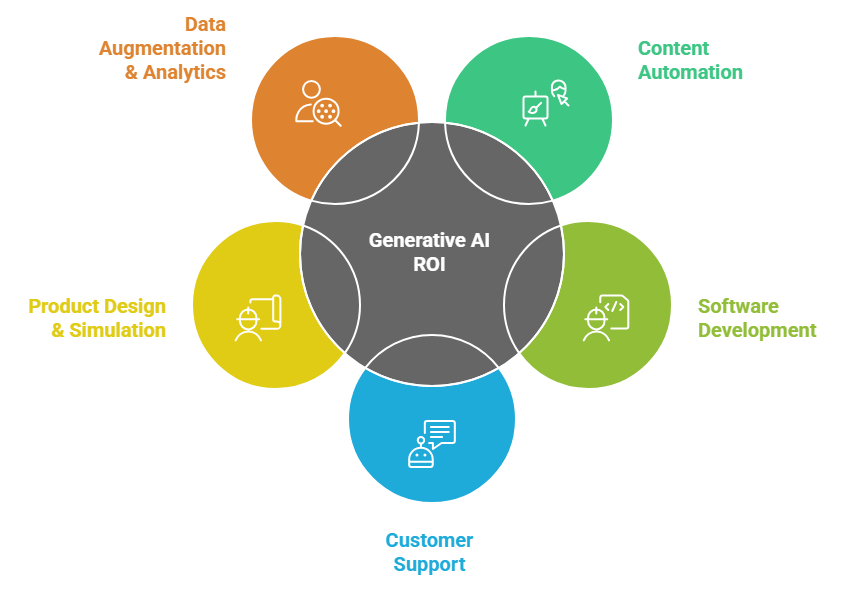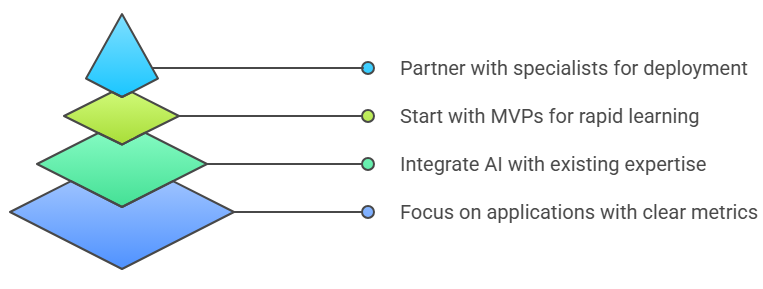Generative AI has become central to enterprise operations, with companies adopting AI-powered tools and solutions to streamline processes. According to a 2024 McKinsey study, organizations implementing generative AI report average productivity gains of 35-50%, with 75% of executives expecting significant revenue impact within three years.
However, every forward-thinking leader must address a critical question: Does generative AI deliver measurable ROI, or does it represent technology spending without clear returns? With organizations investing millions in AI initiatives, understanding the financial impact becomes essential for strategic decision-making.
This detailed guide helps businesses evaluate whether generative AI represents a worthwhile investment for their operational needs.
What is generative AI?
Generative artificial intelligence creates new content, code, designs, and data using advanced machine learning models. These systems include large language models (LLMs) like GPT and Claude, which generate human-quality text, Generative Adversarial Networks (GANs), which produce realistic images and videos, and diffusion models, which create detailed visual content from text descriptions.
Unlike traditional AI, which analyzes and classifies existing data, generative AI produces original outputs by learning patterns from vast datasets. This technology enables businesses to automate creative processes, accelerate development workflows, and generate synthetic data for training purposes, making it a powerful tool for enhancing productivity across multiple business functions.
Businesses across various sectors are implementing generative AI to enhance productivity and create value through multiple applications:

Content creation and marketing
Marketing teams use generative AI to produce blog posts, social media content, email campaigns, and product descriptions at scale, maintaining brand consistency while reducing content production time from weeks to hours.
Software development and engineering
Development teams integrate AI coding assistants to generate code snippets, debug applications, and automate testing processes. Many developers report 30 to 50 percent productivity improvements in routine tasks.
Product design and prototyping
Design professionals leverage generative tools to create product mockups, architectural renderings, and industrial designs. These tools enable rapid concept iteration while optimizing specifications for manufacturing efficiency and cost effectiveness.
Customer support and service
Organizations deploy intelligent chatbots and virtual assistants to handle customer inquiries, provide technical support, and process service requests, offering continuous availability while reducing workload on human agents.
Data analysis and synthetic data generation
Companies generate synthetic datasets for training machine learning models and create data visualizations, reports, and analytical insights, accelerating decision-making processes and reducing dependency on specialized analysts.
Read more about Generative AI for Marketing: Application & Best Practices
Why businesses are investing in GenAI
Smart organizations recognize generative AI as a strategic investment that delivers measurable business value through enhanced operational efficiency, reduced costs, and new revenue opportunities.
Opportunities for revenue growth, cost savings, and efficiency
Organizations implement generative AI to unlock multiple value creation pathways, from automating costly manual processes to developing innovative products that generate new revenue streams and competitive advantages.
Revenue growth through product innovation
Companies develop new AI-powered products and services, creating additional revenue streams while entering previously inaccessible markets with innovative solutions that competitors cannot easily replicate or match.
Operational cost reduction at scale
Businesses automate routine tasks and processes using generative AI, reducing labor costs by up to 40 percent while maintaining quality standards and eliminating human error in repetitive workflows.
Time to market acceleration
Organizations compress development cycles from months to weeks by automating design, testing, and documentation processes. This enables faster product launches and a competitive advantage in dynamic market conditions.
Enhanced customer experience value
AI-powered personalization and support systems increase customer satisfaction scores by 25 percent while reducing service costs, leading to higher retention rates and increased customer lifetime value.
Workforce productivity multiplication
Teams accomplish more complex tasks in shorter timeframes using AI assistance, with knowledge workers reporting 2x to 3x productivity improvements in content creation, analysis, and strategic planning activities.
Industry sectors seeing the Most ROI
Leading industries demonstrate measurable returns from generative AI investments, with manufacturing, healthcare, and technology sectors reporting the highest value creation through strategic implementation and adoption.
Manufacturing excellence and optimization
Manufacturing companies use generative AI for predictive maintenance, quality control automation, and supply chain optimization, achieving 15% to 30% reductions in downtime and operational expenses through intelligent process management.
Healthcare innovation and patient care
Healthcare organizations implement AI for drug discovery acceleration, diagnostic imaging enhancement, and personalized treatment planning, reducing research timelines by years while improving patient outcomes and care delivery efficiency.
SaaS platform enhancement and growth
Software companies integrate generative AI features into their platforms, increasing user engagement by 40% while reducing customer churn through enhanced functionality and automated customer success initiatives.
Financial services transformation and compliance
Financial institutions deploy AI for fraud detection, risk assessment automation, and regulatory reporting, achieving faster compliance processes while maintaining accuracy and reducing operational risk exposure.
Retail and e-commerce personalization
Retail businesses leverage generative AI for inventory optimization, personalized marketing campaigns, and dynamic pricing strategies, increasing conversion rates while improving customer satisfaction metrics.
What Goes Into Calculating ROI of Generative AI?
Accurate ROI calculation requires a comprehensive analysis of investment costs and returns, including tangible financial benefits and value creation across operational and strategic business dimensions.
Investment costs
Understanding total implementation costs helps organizations budget effectively and set realistic expectations for generative AI projects, ensuring proper resource allocation and timeline planning for successful deployment.
Software licensing and platform costs
Organizations typically invest $50,000 to $500,000 annually in AI platform subscriptions, API usage fees, and enterprise software licenses, with costs scaling based on usage volume and feature requirements.
Specialized talent acquisition and retention
Companies spend $150,000 to $300,000 per AI specialist for salaries, benefits, and retention bonuses, with additional recruiting costs averaging $25,000 to $50,000 per successful technical hire in competitive markets.
Employee training and skill development
Businesses allocate $2,000 to $10,000 per employee for AI literacy programs, technical workshops, and certification courses, ensuring teams can effectively utilize new tools and maximize productivity gains.
System integration and infrastructure setup
Technical implementation requires $100,000 to $1,000,000 for API integrations, data pipeline development, security configurations, and cloud infrastructure setup, depending on organizational complexity and existing technology stack.
Ongoing maintenance and support services
Annual maintenance costs range from 15 to 25 percent of the initial implementation investment, covering system updates, technical support, performance monitoring, and security maintenance for sustained operation.
Tangible returns
Measurable financial benefits provide clear justification for AI investments, with organizations tracking specific metrics like time savings, productivity improvements, and direct cost reductions across business functions.
Time savings and efficiency gains
Teams report a 40% to 70% reduction in task completion times for content creation, data analysis, and routine documentation, translating to a $100,000 to $500,000 annual value per department.
Productivity improvements and output quality
Organizations achieve 2x to 4x productivity increases in creative and analytical work, with employees completing more projects while maintaining or improving quality standards and meeting tighter deadlines.
Direct cost reduction and resource optimization
Companies reduce operational expenses by 20 to 50% by automating manual processes, eliminating third-party services, and optimizing resource allocation across departments.
Intangible returns
Strategic benefits create long-term competitive advantages that may not appear immediately in financial statements but contribute to market positioning, customer loyalty, and sustainable business growth.
Innovation acceleration and market differentiation
AI-powered innovation cycles enable faster product development, unique feature creation, and market entry opportunities that establish competitive advantages and capture greater market share over time.
Enhanced customer experience and satisfaction
Improved service quality, personalized interactions, and faster response times increase customer loyalty, reduce churn rates, and generate positive word of mouth marketing that drives organic growth.
Brand leadership and industry recognition
Early AI adoption positions organizations as technology leaders, attracting top talent, premium partnerships, and investor interest while building a reputation as forward-thinking industry innovators.
Sample ROI formula or framework
You can calculate generative AI ROI using this comprehensive framework:
ROI = (Total Benefits – Total Costs) / Total Costs × 100.
Let’s take an example:
If a company’s annual benefits equal $800,000 and total investment costs equal $500,000, the ROI equals 60 percent, indicating strong returns that justify continued investment and potential expansion.
Top areas where generative AI drives ROI
Organizations achieve the highest returns by focusing on specific business functions where AI creates measurable value, from content automation to product development acceleration.
1- Content automation
Marketing departments leverage generative AI to transform content workflows, enabling faster campaign development and personalized customer engagement while reducing external agency dependencies and operational costs.
Faster content creation, SEO gains, and campaign personalization
- AI produces blog posts, social media content, and email campaigns in minutes.
- Teams generate hundreds of content variations, create personalized messaging, and optimize for SEO automatically.
ROI: reduced agency spend, increased engagement
- Companies save $200,000 to $500,000 annually on content creation while increasing email open rates by 30 percent.
- Social media engagement improves by 45 percent with faster campaign deployment.
2- Software development
Development teams integrate AI coding assistants to accelerate software creation, improve code quality, and reduce debugging time, enabling faster product launches and more efficient development cycles.
AI-assisted coding and QA
- AI writes code snippets, generates unit tests, and identifies bugs automatically.
- Developers use tools like GitHub Copilot to complete functions and optimize code for better performance.
ROI: accelerated product launches, reduced bug fixing cost
- Organizations accelerate product launches by 2 to 6 months while decreasing maintenance expenses by 25 percent.
- Development teams require 20 percent fewer resources for project completion.
3- Customer support
Organizations deploy AI-powered customer service solutions to handle routine inquiries, provide instant support, and improve customer satisfaction while reducing operational costs and human agent workload.
AI chatbots, self-service tools
- AI chatbots handle customer conversations with natural language processing and access knowledge bases.
- Self service portals help customers troubleshoot problems through guided workflows and tutorials.
ROI: lower support costs, improved satisfaction
- Companies decrease response times from 15 minutes to 3 minutes per inquiry while resolving 70 to 85 percent of issues automatically.
- Using generative AI, customer retention rates increase by 15 percent.
4- Product design & simulation
Design teams utilize generative AI for rapid prototyping, optimization, and testing across manufacturing, architecture, and product development, reducing design cycles and improving innovation outcomes.
Generative design in manufacturing or architecture
- AI creates multiple design variations based on material constraints and performance requirements.
- Engineering teams generate optimized solutions that improve functionality while reducing material usage and weight.
ROI: Fewer Iterations, Reduced Prototyping Cost
- Organizations reduce prototyping costs by 50 to 80 percent and save $500,000 to $2,000,000 annually.
- Design cycles accelerate from months to weeks with improved quality.
5- Data augmentation and analytics
Organizations leverage generative AI to create synthetic datasets, enhance machine learning models, and generate analytical insights, improving decision-making capabilities while reducing data collection costs.
Synthetic data for better ML models
- AI creates synthetic datasets that supplement real-world data for machine learning training.
- Healthcare and financial organizations generate realistic data while protecting privacy and sensitive information.
ROI: improved model accuracy, lower training costs
- Organizations achieve 15 to 30 percent better model accuracy while reducing data acquisition costs by 60 to 90 percent.
- Teams complete development 40 percent faster.
Read more about Building an Optimized Generative AI Tech Stack
Real-world ROI examples
Organizations across industries demonstrate measurable returns from generative AI investments through documented case studies that showcase specific productivity improvements, cost savings, and revenue growth across different business functions.
Case Study 1: Wayfair’s AI product catalog automation achieves 5x faster updates
Wayfair, the leading online furniture retailer, implemented generative AI to automate its product catalog enrichment processes. The company now updates product attributes 5x faster than before, achieving significant operational cost savings while maintaining catalog quality.
This automation enables Wayfair to process thousands of product descriptions, specifications, and marketing content much more efficiently. The implementation demonstrates how large scale retailers can leverage AI to streamline content operations while reducing manual workload and improving accuracy across massive product inventories.
Source: Google Cloud Blog – Real-world gen AI use cases from industry leaders
Case Study 2: United Wholesale Mortgage doubles underwriter productivity with AI
United Wholesale Mortgage transformed its mortgage processing operations using Vertex AI, Gemini, and BigQuery, achieving more than double underwriter productivity in just nine months. This dramatic improvement resulted in shorter loan closing times for 50,000 brokers and their clients, directly improving customer satisfaction and business efficiency.
The implementation showcases how enterprise financial services can leverage generative AI to accelerate complex document processing and decision-making workflows while maintaining regulatory compliance and quality standards.
Source: Google Cloud Blog – Real-world gen AI use cases from industry leaders
Challenges that can lower ROI
Understanding potential obstacles helps organizations avoid common pitfalls that reduce generative AI returns and implement more effective strategies for sustainable value creation.
Poor use case selection
Organizations often choose AI applications that provide minimal business impact or require complex implementations with uncertain outcomes. Starting with low-value tasks delays meaningful results and wastes resources on projects that cannot demonstrate clear ROI.
Lack of AI-ready data
Many companies attempt AI implementation without properly structured, clean, or accessible data, leading to poor model performance and unreliable outputs. Insufficient data quality creates additional costs for cleaning and preparation while reducing the accuracy of AI-generated results.
Integration with legacy systems
Existing technology infrastructure may not support modern AI tools, requiring expensive upgrades or custom development to connect new solutions. Complex integration projects often exceed budgets and timelines while creating technical debt that increases long-term maintenance costs.
Overreliance without human oversight
Teams that deploy AI without proper human review processes risk quality issues, compliance problems, and customer dissatisfaction from automated errors. Excessive automation can lead to loss of institutional knowledge and reduced ability to handle exceptions or complex scenarios.
Maximizing the ROI of generative AI

Strategic implementation approaches ensure organizations achieve maximum value from AI investments while avoiding common pitfalls that reduce returns and business impact.
Choose high-impact use cases
Focus on applications that address pressing business pain points or create substantial value through automation and improved efficiency. Prioritize projects with clear metrics and measurable outcomes that directly contribute to revenue growth or cost reduction.
Combine genAI with domain-specific knowledge
Integrate AI tools with existing expertise and business processes to create more accurate and relevant outputs for specific industry requirements. Domain knowledge ensures AI applications align with business context and produce results that meet quality and compliance standards.
Start with MVPs and iterate
Begin with minimum viable products that demonstrate value quickly and allow for rapid learning and improvement based on user feedback. Iterative development reduces risk while enabling teams to refine approaches and scale successful implementations across larger business areas.
Work with experienced AI development partners
Partner with specialists like Folio3 who understand both AI technology and business implementation to accelerate deployment and avoid common mistakes. Experienced partners provide proven methodologies and technical expertise that reduce implementation time and improve project success rates.
Is generative AI worth the investment?
Yes, organizations that approach generative AI strategically with clear goals and proper implementation consistently achieve positive returns while avoiding common pitfalls that reduce value.
It’s not about replacing humans—it’s about augmenting them. The highest ROI comes from AI implementations that enhance human capabilities rather than attempting to replace skilled workers entirely. Augmentation approaches create sustainable competitive advantages while maintaining the human judgment and creativity essential for business success.
Explore more about Generative AI In Manufacturing
How Folio3 AI can help with generative AI solutions
Folio3 AI delivers comprehensive generative AI solutions that maximize business ROI through strategic implementation, custom model development, and proven methodologies backed by 15+ years of experience.
Custom AI Model Development and Fine Tuning Folio3 specializes in building tailored generative AI models using GANs, transformers, and reinforcement learning technologies that align perfectly with your specific business strategies and operational workflows.
End to End Strategic Planning and Deployment Our team provides complete strategic guidance from opportunity identification to goal definition and seamless system integration, ensuring AI solutions deliver measurable returns across your organization.
Ongoing Optimization and Industry Expertise With 1000+ enterprise clients and 20+ pre-built models deployed globally, Folio3 offers continuous model updates and performance optimization to maintain effectiveness as businesses scale.
Final thoughts
The ROI of generative AI is real and measurable for organizations that approach implementation strategically. While generative AI is not a magic solution, companies that choose appropriate use cases, invest in proper training, and maintain human oversight consistently achieve strong returns. AI delivers tangible business value across industries, from content automation that reduces marketing costs by 60 percent to development tools that accelerate product launches.
Success requires realistic expectations, proper planning, and focus on augmenting human capabilities rather than replacing them entirely. Organizations ready to maximize their generative AI ROI should partner with experienced providers who understand both technology capabilities and business requirements.
Ready to see what kind of ROI generative AI can deliver for your business? Let’s talk
Frequently asked questions
Q1: How long does it take to see ROI from generative AI investments?
Most organizations begin seeing measurable returns within 3 to 6 months of implementation, with full ROI typically achieved within the first year. Early wins often come from automation of routine tasks and improved efficiency in content creation and customer support.
Q2: What is the average cost of implementing generative AI for mid-size businesses?
Implementation costs typically range from $100,000 to $500,000 for mid size businesses, including software licensing, integration, and training. However, most companies recover these costs through productivity gains and operational savings within 12 to 18 months.
Q3: Which business functions show the highest ROI from generative AI?
Marketing and content creation typically deliver the highest returns, with 40 to 70 percent cost reductions and significant engagement improvements. Software development and customer support also show strong ROI through accelerated processes and improved service quality.
Q4: Do businesses need technical expertise to implement generative AI successfully?
While technical knowledge helps, partnering with experienced AI development companies like Folio3 allows businesses to implement solutions without extensive in-house expertise. Professional guidance ensures proper strategy, deployment, and ongoing optimization for maximum ROI.
Q5: How can businesses measure the success of their generative AI investments?
Success metrics include productivity improvements, cost savings, time reduction, and revenue growth across specific business functions. Regular monitoring of KPIs like content creation speed, customer satisfaction scores, and operational efficiency provides clear ROI measurement frameworks.

Laraib Malik is a passionate content writer specializing in AI, machine learning, and technology sectors. She creates authoritative, entity-based content for various websites, helping businesses develop E-E-A-T compliant materials with AEO and GEO optimization that meet industry standards and achieve maximum visibility across traditional and AI-powered search platforms.









